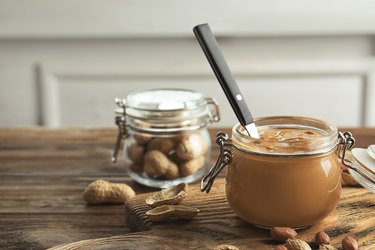
Every year, Americans consume approximately 700 million pounds of peanut butter. It's a healthy choice as the spread offers plenty of vitamins, minerals, plant protein, fiber and good fats. Because of its low glycemic index of 14, peanut butter helps prevent disease, satisfies hunger and lifts your energy by stabilizing your blood sugar.
Read more: Is Peanut Butter Bad for Weight Loss?
Video of the Day
Video of the Day
Glycemic Index Explained
The glycemic index, or GI, is a number on a 100-point scale that measures how high your blood sugar rises after you eat specific foods. A GI less than 55 is considered low, while anything 70 or more is considered high.
When a food has a lower GI value, it digests more slowly than higher ranking foods. Low GI foods tend to be absorbed and metabolized at a slower rate, too. This means they have a less dramatic effect on raising your blood sugar, or glucose, levels and thus also have a more moderate effect on your insulin levels.
The glycemic index originated more than 20 years ago as a way for those with diabetes to identify the optimal carbohydrate choices. Foods with a high GI, such as baked goods, processed cereals, potatoes, pretzels and short-grain rice, cause quick and high rises and drops in blood sugar. Low GI foods such as fruit, vegetables, whole grains, dairy products and peanut butter can help stabilize blood sugar.
Peanut Butter Ranking
Peanut butter has a glycemic index of 14. This low ranking means peanut butter can help stabilize blood sugar and insulin levels, unlike high GI foods that rapidly spike your glucose levels.
These high spikes adversely affect your energy level and can cause stress on your body that leads to disease. Having steady blood sugar levels helps keep your heart healthy, possibly prevents diabetes, reduces hunger and weight, maintains energy levels and may even improve fertility.
Balancing Act
When eaten with refined carbohydrates, or high-GI food, peanut butter also helps moderate the subsequent blood sugar rise. Peanuts are helpful in keeping stable blood sugar levels in healthy people and in people with diabetes.
Snack on a spoonful of peanut butter or spread it on a low-GI food, such as celery, between meals to help maintain a steady blood sugar. Even though it can help offset high GI-foods, if you do choose it in sandwich form, opt for whole-grain bread, which has a lower GI ranking than white, refined bread.
Choosing peanut butter at breakfast can also have a positive effect on your blood sugar levels for the entire day, showed a 2013 study published in the British Journal of Nutrition.
Women at high risk for type 2 diabetes who consumed 1.5 ounces of peanuts or peanut butter at breakfast experienced fewer blood sugar spikes later in the day than those who did not have the peanuts, despite a high-carb lunch. The peanut butter eaters also reported greater sensations of fullness and a decreased desire to eat.
Read more: Do Peanuts Cause Weight Gain?